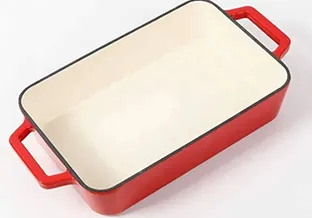
choosing cast iron skillet
Choosing the Right Cast Iron Skillet A Guide for Home Cooks
Cast iron skillets have long been a staple in kitchens around the globe. Their durability, exceptional heat retention, and versatility make them a favorite among both novice and experienced cooks. However, choosing the right cast iron skillet can be overwhelming, given the plethora of options available. This guide will help simplify your decision-making process.
1. Understanding Cast Iron
Before diving into the selection process, it’s essential to understand what cast iron is. Cast iron is a material that can retain heat exceptionally well, making it perfect for searing, sautéing, baking, and frying. It also develops a natural non-stick surface when seasoned correctly, which can enhance the flavor of your food as well as make cooking and cleaning easier.
2. Pre-Seasoned vs. Unseasoned
When shopping for a cast iron skillet, you will encounter two main types pre-seasoned and unseasoned. Pre-seasoned skillets have a layer of vegetable oil baked onto the surface, allowing for immediate use. This option is great for beginners who may not want to deal with the initial seasoning process. On the other hand, unseasoned skillets require a bit of work to prepare. You’ll need to season the skillet yourself, which can be an enjoyable and rewarding experience for those who love cooking.
3. Size Matters
Cast iron skillets come in various sizes, typically ranging from 6 inches to 15 inches in diameter. The size you choose should largely depend on your cooking needs and the number of servings you prepare regularly. For a small family or occasional use, a 10-inch skillet is usually sufficient. However, if you frequently cook for larger groups or enjoy making dishes like paella or frittatas, you might want to opt for a larger size.
choosing cast iron skillet

4. Weight Considerations
Cast iron skillets are known for their heft. While the weight contributes to their ability to retain heat, it can also be cumbersome. When selecting a skillet, consider how comfortable you feel lifting it, especially when it’s full of food. Manufacturers often produce skillets that still offer heat retention but are lighter, making them easier to handle.
5. Handle Features
Another factor to consider is the handle design. Some skillets come with a sturdy, integrated handle, while others might feature a helper handle on the opposite side. A helper handle can be particularly useful when maneuvering larger skillets. Additionally, consider how the handle feels in your hand. A comfortable, heat-resistant handle can significantly enhance your cooking experience.
6. Care and Maintenance
Cast iron skillets require some maintenance to keep them in top shape. It’s essential to clean them properly after use, typically by rinsing with warm water and using a pan brush. Avoid using soap, as it can strip the seasoning. After washing, dry the skillet thoroughly and apply a thin layer of oil to maintain its seasoning.
Conclusion
Choosing the right cast iron skillet can elevate your cooking experience. By considering factors such as seasoning, size, weight, handle design, and maintenance, you'll be well-equipped to select a skillet that suits your culinary needs. Remember, investing in a cast iron skillet is not just about purchasing a cooking tool; it’s about embracing a time-honored tradition that can enhance your meals for years to come. Happy cooking!
-
Season Cast Iron Perfectly with GPT-4 Turbo TipsNewsAug.01,2025
-
High Quality Cast Iron Cookware - Baixiang County Zhongda MachineryNewsAug.01,2025
-
Premium Cast Iron Pan: Durable & Perfect HeatNewsAug.01,2025
-
High Quality Kitchen Durable Black Round Cast Iron Cookware Pancake Crepe Pan-Baixiang County Zhongda Machinery Manufacturing Co., Ltd.NewsAug.01,2025
-
Cast Iron Cookware - Baixiang County Zhongda Machinery | Nonstick, Heat ResistanceNewsAug.01,2025
-
High Quality Kitchen Durable Black Round Cast Iron Cookware - Baixiang County Zhongda Machinery | Non-Stick, Heat Retention, DurableNewsJul.31,2025


